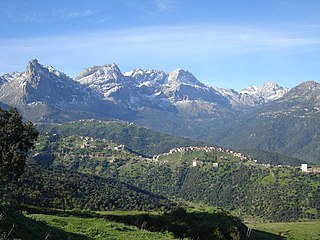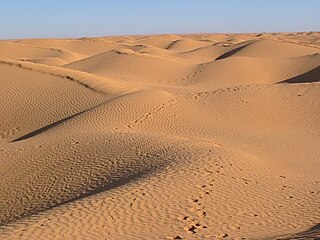
Algeria comprises 2,381,740 square kilometres (919,590 sq mi) of land, more than 80% of which is desert, in North Africa, between Morocco and Tunisia. It is the largest country in Africa. Its Arabic name, Al Jazair, is believed to derive from the rocky islands along the coastline of the Mediterranean Sea. The northern portion, an area of mountains, valleys, and plateaus between the Mediterranean and the Sahara Desert, forms an integral part of the section of North Africa known as the Maghreb. This area includes Morocco, Tunisia, and the northwestern portion of Libya known historically as Tripolitania.

Kabylia or Kabylie is a mountainous coastal region in northern Algeria and the homeland of the Kabyle people. It is part of the Tell Atlas mountain range and is located at the edge of the Mediterranean Sea.

Kabyle or Kabylian is a Berber language (tamazight) spoken by the Kabyle people in the north and northeast of Algeria. It is spoken primarily in Kabylia, east of the capital Algiers and in Algiers itself, but also by various groups near Blida, such as the Beni Salah and Beni Bou Yaqob.

Tizi Ouzou or Thizi Wezzu is a city in north central Algeria, and capital of Tizi Ouzou Province and Tizi Ouzou District. It is among the largest cities in Algeria. It is the second most populous city in the Kabylia region after Béjaïa.

The Kabyle people are a Berber ethnic group indigenous to Kabylia in the north of Algeria, spread across the Atlas Mountains, 160 kilometres (100 mi) east of Algiers. They represent the largest Berber population of Algeria and the second largest in North Africa.

The Algerian Ligue Professionnelle 1, known as Championnat National de Première Division or Ligue 1 for short, and formerly known as the Championnat National 1, is the Algerian professional league for association football clubs. It is the country's primary football competition and serves as the top division of the Algerian football league system. Administered by the Ligue de Football Professionnel, it is contested by 16 clubs, with the two lowest-placed teams at the end of each season being relegated to the Ligue 2 and replaced by the top two teams in that division. In 2009 it was known as Championnat d'Algérie D1 Nedjma and from 2010 to 2014, it was known as Ligue Professionnelle 1 Nedjma as it is sponsored by Kuwaiti telecommunications company Nedjma. From 2014, the league is officially known as Ligue Professionnelle 1 Mobilis as it is sponsored by Algerian telecommunications company Mobilis.

The Grand Erg Oriental is a large erg or "field of sand dunes" in the Sahara Desert. Situated for the most part in Saharan lowlands of northeast Algeria, the Grand Erg Oriental covers an area some 600 km wide by 200 km north to south. The erg's northeastern edge spills over into neighbouring Tunisia.

Olympique de Médéa, also known as 'O Médéa or simply OM for short, is an Algerian football club based in Médéa. The club was founded in 1945 and its colours are orange and blue. Their home stadium, Lyes Imam Stadium, has a capacity of 12,000 spectators. The club is currently playing in the Algerian Ligue 2.

The Algerian Desert is a desert located in central North Africa within Algeria, constituting part of the Sahara. The desert covers more than 90% of Algeria's total area. In 2018, it was home to a population of 3,600,000 inhabitants, or 10.5% of the Algerian population.
The 2010–11 season was JS Kabylie's 41st season in the Algerian Ligue Professionnelle 1. They competed in Ligue 1, the 2010 CAF Champions League and the Algerian Cup.
Chemseddine Nessakh is an Algerian footballer who plays for ASO Chlef in the Algerian Ligue Professionnelle 1 and the Algeria national team.
Union Sportive Musulmane Madinet Hadjout, known as USMM Hadjout or simply USMMH for short, is an Algerian football club based in Hadjout. The club was founded on 5 March 1947 and its colours are green and white. Their home stadium, Stade du 5-Juillet-1962, has a capacity of 10,000 spectators. The club is currently playing in the Inter-Régions Division.
Football clubs from Algerian Ligue Professionnelle 1 (Algeria) have been the most successful in Africa. since 1970, twenty-four Algerian clubs have evolved into African competitions. They can participate each year according to their results during the previous season in the various national competitions, during the sixties no Algerian club engages. The African football competitions are relatively recent and that there was only the African Cup of Champion Clubs, the first edition of which dates from the year 1964. This can be explained first by the fact that at that time most African countries recently gained independence. Everyone was not at the same level in terms of football, on the other hand there were also other football competitions whose geographical scope was restricted and represented only part of the African continent. These well established since the early sixties, the continental dimension of a test was still difficult to admit and tolerate, moreover the first editions will be organized and won by countries in the center and East of the continent African.
Mohamed Seghir Boushaki, was an Algerian Kabyle politician after the French conquest of Algeria.

The clasico kabylo-algérois is the name given to matches between USM Alger and JS Kabylie football clubs from Tizi Ouzou and Algiers, Algeria they are considered one of the most famous clubs in Algeria and their matches are given great attention by the Algerian media, The period between 1996 and 2010 is the most exciting between the two teams because of the great conflict between the heads of the two teams Saïd Allik and Mohand Chérif Hannachi, It is said that the reason for the enmity between the two when Said Alik bringing the star of JS Kabylie and national team at the time Mahieddine Meftah the two teams were both champions and runners-up in the same season five times, including three consecutive times between 2003–04 and 2005–06.
Operation Véronique was an unsuccessful military operation undertaken by the French Army during the Algerian War in the hope of eradicating the FLN.

The Battle of the Col des Beni Aïcha or Battle of Thenia, which broke out on 19 April 1871, was a battle of the Mokrani Revolt between the Algerian rebels, and the France, which was the colonial power in the region since 1830.
Meraldene or Merabtene is a village in the Boumerdès Province in Kabylie, Algeria.
Azela is a village in the Boumerdès Province in Kabylie, Algeria.
Events from 2021 in Algeria.










